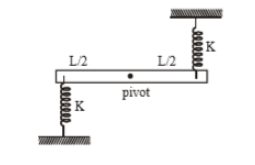A particle is subjected to two simple harmonic motions in the same direction having equal amplitudes and equal frequency. If the resulting amplitude is equal to the amplitude of individual motions, the phase difference between them is:
1.
2.
3.
4.
The uniform stick of mass m length L is pivoted at the centre. In the equilibrium position shown in the figure, the identical light springs have their natural length. If the stick is turned through a small angle , it executes SHM. The frequency of the motion is:

(1)
(2)
(3)
(4) None of these
Two simple pendulums have time periods T and . They start vibrating at the same instant from the mean position in the same phase. The phase difference between them when bigger pendulum completes one oscillation will be:
1.
2.
3.
4.
There is a simple pendulum hanging from the ceiling of a lift. When the lift is stand still, the time period of the pendulum is T. If the resultant acceleration becomes g/4, then the new time period of the pendulum is
(1) 0.8 T
(2) 0.25 T
(3) 2 T
(4) 4 T
When two displacements represented by y1=asin(ωt) and y2=bcos(ωt) are superimposed,the motion is -
(1) not a simple harmonic
(2) simple harmonic with amplitude a/b
(3) simple harmonic with amplitude
(4) simple harmonic with amplitude (a+b)/2
A S.H.M. has amplitude ‘a’ and time period T. The maximum velocity will be -
(1)
(2)
(3)
(4)
Two particles P and Q start from origin and execute Simple Harmonic Motion along X-axis with same amplitude but with periods 3 seconds and 6 seconds respectively. The ratio of the velocities of P and Q when they meet is -
(1) 1 : 2
(2) 2 : 1
(3) 2 : 3
(4) 3 : 2
| 1. | \(A_1 \omega_1=A_2 \omega_2=A_3 \omega_3\) |
| 2. | \(A_1 \omega_1^2=A_2 \omega_2^2=A_3 \omega_3^2\) |
| 3. | \(A_1^2 \omega_1=A_2^2 \omega_2=A_3^2 \omega_3\) |
| 4. | \(A_1^2 \omega_1^2=A_2^2 \omega_2^2=A^2\) |
The amplitude of a particle executing SHM is 4 cm. At the mean position the speed of the particle is 16 cm/sec. The distance of the particle from the mean position at which the speed of the particle becomes
will be
(1)
(2)
(3) 1 cm
(4) 2 cm
The maximum velocity of a simple harmonic motion represented by is given by
(1) 300
(2)
(3) 100
(4)






